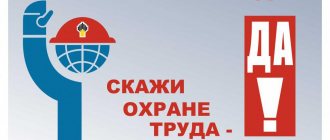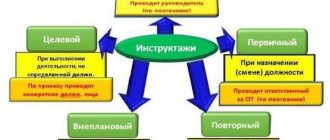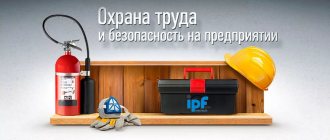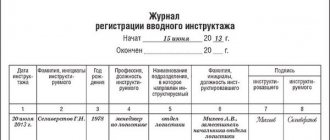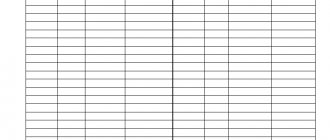The safety magazine, a sample download of which we will offer below, is used in a variety of areas. In production, at the factory, upon entering a job, even for students, similar instructions are provided. The document in question includes subsections - perhaps fire safety, rules for handling equipment and reagents (for example, in computer science, chemistry, physics lessons). In general terms, this is the name for a whole group of departmental documents that relate to the field of labor protection.
Legal norms
By law, the requirement to maintain a safety log applies to every employer. He is required to be present at production, in the office and when carrying out new work on other equipment. The fact that the employee is aware of the safety rules is indicated in the form, which is confirmed by his personal signature. The form of this form must comply with GOST.
Important! After filling out the log, it must be handed over to the archive, where it is stored permanently.
Particular attention is paid to maintaining, filling out and storing such a document in hazardous industries where there is a risk of injury and disfigurement. If an employee is not given introductory, repeated or other types of training, and he is injured or even killed, the employer will face a large fine and even criminal liability. Of course, it is important to register that the training has been completed; for this in 2021, as in previous years, a signature from the employee is required in the log. It is also important to observe the frequency of briefings and the rules for maintaining the journal itself.
Types of instruction
Safety instructions are divided into types :
- Introductory.
- Target.
- Extraordinary,
- Repeated.
Induction training is carried out with a new person hired or with an employee who has changed his type of activity.
The target is carried out along the line. Its result is that the employee receives permission to work, which is usually of a one-time nature. For example, this could be eliminating an accident.
In case of an extraordinary event, an entry is made in the journal explaining the reason for it.
Repeated training is carried out most frequently. This is a periodic test of employees’ knowledge of maintenance.
Kinds
There are several types of instruction:
- Introductory. It is carried out with everyone who comes to work. The safety engineer or the manager directly is responsible for this if the company is small. Its essence is to conduct an explanatory conversation with a newcomer and familiarize himself with the instructions. It is carried out exclusively individually. The results of its implementation are entered into the journal.
- Repeated. The need for its implementation is prescribed by law. It is required to be carried out every 6 months, regardless of the company’s activity. This need arises to update the initial briefing data. It can be carried out unscheduled if it is necessary to familiarize employees with new data. This type of training is group in nature and is carried out only by an authorized person.
- Target. Such a study of instructions is narrowly focused. The main goal is to educate the employee about the specifics of implementing a particular task. They are carried out at construction sites, factories or when transferring to a new site. This instruction is required to avoid harm to health and life; it is individual.
- Unscheduled. Does not apply to the training plan that is recorded at the enterprise. It is practiced when introducing a new work scheme, introducing other equipment and when launching an additional technological process.
Important! In some cases, unscheduled training is associated with systematic violations of safety regulations or emergency situations at the enterprise. Sometimes it is carried out at the request of higher authorities.
Control over the lead
The head of the unit checks the safety log daily, regardless of whether there are new entries or not. This is the first degree of control. The head of the labor protection department is also responsible; he must check its registration. In his job description, this form of control is listed as monthly. Moreover, the journal must contain his visa regarding the presence or absence of violations of conduct. Even the CEO should check the log once a quarter. This is the last stage of control. If everyone responsible knows how the document should be filled out correctly and controls its maintenance, there will be no problems with inspection authorities and no penalties.
Journal control
The fully completed journal is submitted to the archives. It can be stored without any time limit . Every employer is required to keep a safety training log. Failure to comply will result in a heavy fine. If an accident resulting in injury or death, imprisonment .
The head of the unit is required to check the log daily . Then it is checked monthly by the head of the health and safety department . A record is made in the log of all detected violations or their absence is noted. The final controller is the general director. Sometimes this is entrusted to the chief engineer.
The second and third stages of control can be carried out by specially created control structures. This happens in small organizations.
Responsible person: compilation and maintenance
Control is assigned to many levels, but only one is involved in compilation and maintenance. An example of a magazine can be found below and downloaded in Word format for free.
The forms, which are uniform for all structural divisions of the enterprise, are stored in one place and by one person - an occupational safety and health engineer. In small companies, such duties are assigned to any other employee, and a corresponding order is issued. The responsible person is obliged to keep a log in accordance with the following rules:
- numbering of all pages;
- firmware certified by management;
- presence of the signature and seal of the manager;
- A stationery book with an A4 format spread is used for maintenance;
- the working field consists of 12 line columns;
- if the entry is very long, then multiple lines are allowed;
- dashes are entered in empty columns;
- the cover and paper must be wear-resistant, since the document is designed for long-term use and permanent storage.
Important! Large enterprises most often order such forms from a printing house, although they can be printed according to the example given.
Contents of the safety magazine:
The log contains the following data in rows in order:
- record number;
- date of;
- FULL NAME. the employee who is being instructed;
- date and year of birth of the instructee;
- indication of profession and position. In some cases, instruction may be given to an employee of another organization. In this case, it is necessary to enter data regarding the details of the official ID or order, which is the basis for the employee’s presence at the briefing;
- type of training provided. If the purpose is repeated or extraordinary, the reason for the purpose should be indicated;
- FULL NAME. the one who conducts the training;
- signature of the person for whom the training was conducted and the person who carried it out. It is very important that the autograph of both one and the other be affixed with an indelible pen;
- If necessary, data on the number of shifts and the date of internship is entered.
Important! Based on the specifics of the enterprise’s activities, the structure of the journal may differ slightly. One general rule is that it requires filling out.
General filling rules
One of the rules that many enterprises neglect is full name. The employee who is undergoing training must be recorded in full in the workplace safety log. When maintaining registration, it is not allowed to skip lines. Corrections are not allowed.
If students are doing internships at the enterprise, then safety training should be carried out before each laboratory cycle and when performing one-time work that is not related to direct responsibilities. For example, before being involved in a cleanup or cleaning the area.
The storage period for magazines is 10 years. This type of journal is subject to Order of the Ministry of Culture No. 558 of August 25, 2010, in contrast to the journal where accidents are recorded. The latter must be stored for 45 years.
The journal is maintained continuously throughout the entire life of the enterprise.
What does the TB magazine regulate?
Maintaining it is a norm of law, but many companies have elevated filling out the form in question to the category of formal. For them, this is a way to relieve themselves of responsibility. At the same time, maintaining it and conducting regular briefings makes much more sense and imposes certain obligations. This applies to both the employee and the employer.
Responsibilities of the employee:
- comply with the stated requirements regarding hazardous work. This applies to both work at a construction site and in cultural institutions and offices;
- undergo training according to the employer’s schedule, record this in the journal by signing;
- undergo on-the-job training, be it a workshop or an office;
- confirm knowledge in the field of occupational health and safety.
Employer Responsibilities:
- carry out the required activities for conducting TB training;
- take on-the-job training arrangements;
- provide the required information regarding the safety of all types of work performed in full;
- do not allow those who have not been instructed to work;
- regularly monitor employees’ knowledge in the area in question;
- inform employees about the likely risk of carrying out a particular operation in their workplace.
Journal of initial briefing on labor protection
The workplace safety program is developed by the head of the unit and takes into account the specifics of the activities of a particular unit.
Initial occupational safety classes are conducted before the employee begins independent work. As a rule, after testing practical skills, a mentor is assigned to a given employee. The appointment of a mentor can be done by order, drawn up in free form, based on the information provided by the head of the unit.
Sample Initial Workplace Training Program
Some categories of workers whose duties are not related to:
- operation, maintenance, testing, adjustment and repair of production equipment;
- using an electric or other industrial tool;
- storage and use of raw materials and industrial materials,
may be exempted by the employer from taking these classes (clause 2.1.4 of the Training Procedure approved by Resolution of the Ministry of Labor No. 1/29). However, if the employer decides that certain categories of employees should not undergo classes on primary labor protection, he must issue an order indicating a list of positions and professions of employees who should not undergo primary training at their workplace (the form of such an order is given at the beginning of the material).
When issuing this order, the employer must understand that in the event of an unfavorable combination of circumstances and the occurrence of an accident with such an employee, the fact of failure to complete primary occupational safety classes will be an aggravating factor, regardless of the fact that the law allows this. Therefore, we recommend conducting initial occupational safety classes followed by an examination of each employee (this is calmer and safer for everyone).
Sample form for registering initial training at the workplace
Sample logbook for initial training at the workplace
If employees show unsatisfactory practical skills after appropriate training, the employer is obliged not to allow such employees to work. Such persons must undergo training and knowledge testing again, and they are removed from work by order of the employer, and no wages are accrued to them. The order is issued on the basis of a report or memo from the head of a department or labor protection engineer (in general, submitted by the person who conducted the knowledge test and identified unsatisfactory knowledge).
A journal for registering workplace briefings can be bought at a stationery store or ordered by bank transfer through an online store; its price on average does not exceed 100 rubles per piece.
Administrative responsibility
Recently, cases of violation of safety rules have become more frequent, leading to accidents. This explains the close attention to the management and fulfillment of their obligations by employers. For violation of the rules provided by law, a fine is due:
- for the head of the enterprise - 110-130 thousand rubles;
- safety engineer – 15-25 thousand rubles;
- repeated violation of 200 thousand rubles or suspension of activities for 3 months;
- for an official upon repeated detection, 35-40 thousand rubles, in parallel with a ban on carrying out similar work for 1-3 years;
- if detected violations lead to the death of a person - criminal liability.


